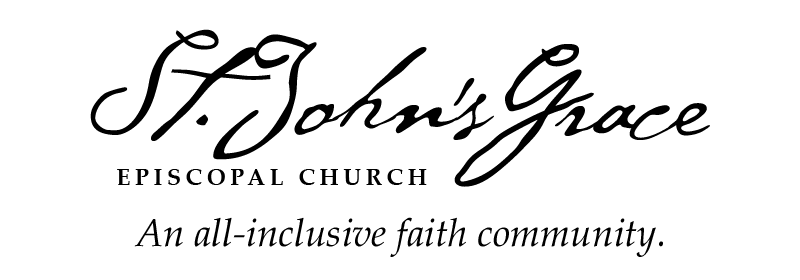Wednesdays in Lent - April 1 - What is the Church?
Wednesdays in Lent Series - St. John’s-Grace & St. Paul’s Cathedral Livestream from St. John’s-Grace
Creative Exploration of the Lent Gospel
Wednesday April 1st at 7:00pm John 11:1-45
What is the Church - Christ Gives Us New Life – The Rev’d Jon F. Lavelle
Wednesday in Lent Schedule:
7:00 – Opening Prayer and Gospel
7:05 – Creative Exploration of the Gospel
8:00 – Concluding Prayer
How to Join: Anyone can join the service by clicking on this link for St. John’s-Grace Livestream: https://zoom.us/j/129327034 This link will be used for all St. John’s-Grace Online Activities. Buckle Your Tech Seatbelts and Pray! It may be a bumpy ride the first time round. You should click on the link on Wednesday evening to download the software which will make it easier to join. Try joining at 6:45pm Wednesday Evening so you we will all be ready when the program begins at 7:00pm.
If you want to join by phone instead of computer video, call: +1 929 205 6099 US (New York) Enter 129 327 034 # when prompted.
(Long distance charges may apply depending on your phone plan)
We have new life in Christ!
What is the church?
DULLES’ MODELS OF CHURCH
* Institution – Typically seen as a formal organization, the church is seen as “the perfect society” that, by its nature, has a structure of governance (a constitution, rules, governing body, recognized leaders, confessional formulas, prescribed forms of public worship). This model expanads the governance function and highlights its place with the three functions of the church: teaching, sanctifying, and governing with the authority of Christ. It also recognizes the body of Christ that affirms this structure and benefits from this structure.
* Mystical Communion – quoting Jerome Hamer – “the mystical body of Christ ia a communion which is at once inward and external, an inner communion of spiritual life (faith, hope, and charity) signified and engendered by an external communion in profession of faith, discipline and sacramental life.” (49) As such, “the communion given by the Holy Spirit finds expression in a network of mutual interpersonal relaitonships of concern and assistance.” (50) Here the church is viewed as the people of God or body of Christ growing into the final perfection of the kingdom. (88)
* Sacrament – as the sign of the intimate union of God with the human community, the church is an instrument of union and unity. It is a visible manifestation of the grace of Christ in the human community calling us to embrace every age, race, kind, and condition and manifest God’s dream both within the church and within the world.
* Herald – As the church is gathered and formed by the word of God, so is its mission to proclaim that which it has heard, believed, and been commissioned to proclaim…. this model is kerygmatic and emphasizes faith and its proclamation. (76) Somewhat paralleling McLuhans’ “the medium is the message, Dulles recognizes that “the gospel is not a system of abstract propositional truths, nor a written document, but rather the event of proclamation itself.”(83)
* Servant – Quoting Richard McBrien, Dulles identifies that the servant church “must offer itself as one of the principle agents whereby the human community is judged by the enduring values of the Gospel of Jesus Christ: freedom, justice, peace, compassion, and reconciliation.” (97) Dedicated to the transformation of the world into the Dream of God, this model calls us to maintain a preferential option for the poor (Boff’s words, not Dulles), the oppressed, and the outcast.
* Community of Disciples – an amalgamation of the other five models, Dulles offers the Community of Disciples as a “supermodel” with the imperative of making Christ present in the world by taking advantage of the strengths of the other models.
What is the church? Church as a Community of Disciples
Bible Readings:
Acts 2:43-47
Life among the Believers
43 Awe came upon everyone, because many wonders and signs were being done by the apostles. 44 All who believed were together and had all things in common; 45 they would sell their possessions and goods and distribute the proceeds to all, as any had need. 46 Day by day, as they spent much time together in the temple, they broke bread at home and ate their food with glad and generous hearts, 47 praising God and having the goodwill of all the people. And day by day the Lord added to their number those who were being saved.
1 Corinthians 12:12-13, 22-26
One Body with Many Members
12 For just as the body is one and has many members, and all the members of the body, though many, are one body, so it is with Christ. 13 For in the one Spirit we were all baptized into one body—Jews or Greeks, slaves or free—and we were all made to drink of one Spirit.
Ephesians 4:11-13
Unity in the Body of Christ
11 The gifts he gave were that some would be apostles, some prophets, some evangelists, some pastors and teachers, 12 to equip the saints for the work of ministry, for building up the body of Christ, 13 until all of us come to the unity of the faith and of the knowledge of the Son of God, to maturity, to the measure of the full stature of Christ.
Q & A
What is the Church?
Who is the head of the Church?
What role do you play in the Church?
Do the Bible readings above describe your church? Which aspects are similar? Which aspects are different?
What can we do to make the church more like the one described in the Bible?

